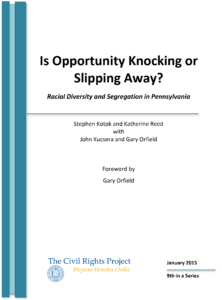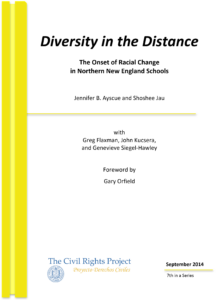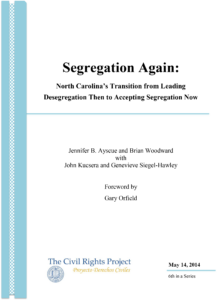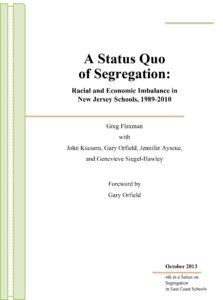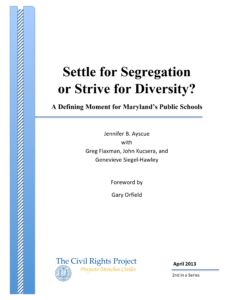Executive Summary
This report analyzes the data on changes in patterns of racial segregation and their educational consequences over a quarter century, from l987 to 2012. The report examines a major transition in the racial and ethnic composition of Connecticut; the changes in integration and segregation in the schools of the state and its urban communities; and the relationship between the racial composition of the schools and the educational consequences. It shows that, in contrast to its neighbors, Massachusetts and New York, Connecticut has made significant progress in reducing segregation as a result of the implementation of the Connecticut Supreme Court’s decisions in the Sheff case and the programs that have been devised and implemented by the state’s educators. Basic findings include:
Statewide
- The white share of the total public school enrollment dropped in the state from 76.8% to 59.9% between 1987 and 2012 while the Latino and Asian share increased substantially as was happening across the U.S. The proportion of Latino students more than doubled, rising from 8.8 to 20.1% over the last twenty-five years. The basic story is that fewer white children were born and the population change reflected the large immigrations to the U.S. from Latin America and Asia. The change did not reflect a surge of black enrollment.
- The overall share of African American and Latino students who attended intensely segregated schools (90-100% minority schools) and apartheid schools (99-100% minority schools) decreased. There was a significant drop in extreme segregation.
- The share of students living in poverty nearly doubled over the last fifteen years from 19.5% to 36.2%, also reflecting national trends. In 2012, the typical African American student attended a school with 63.1% poor students, but the typical white student had 22.3% classmates from low-income families. Segregation was double segregation for students of color.
- Educational outcomes were clearly related to segregation. The overall graduation rate was positively correlated with the proportion of white and Asian students but was negatively linked with the black and Latino share in a school. Academic performance showed the same pattern. This was related to many historic and contemporary inequalities associated with race and ethnicity in U.S. society. The report summarizes a half century of research on the benefits of integration.
- Connecticut’s magnet schools showed great potential of promoting racially integrated schools. In 2012-2013, magnet schools in Connecticut enrolled a more balanced number of students from each racial group (e.g., 30.2% whites, 31.4% blacks, 30.5% Latinos, and 4.4% Asians) as compared to non-magnet schools, which enrolled 61.7% whites, 11.6% blacks, 19.5% Latinos, and 4.8% Asians. Additionally, the typical student of each racial group in Connecticut’s magnet schools attended a similar percentage of low-income students, ranging from 49% to 59%; however, there were noticeable racial disparities in contact with poor students in non-magnet schools from 21% to 62%.
- Connecticut charter schools are far more segregated than traditional public or magnet schools.
Connecticut’s Metropolitan Areas
- Metropolitan areas included 49.2% of the total enrollment of the state’s public schools and their white share of public school enrollment was falling, while the proportion of Latino students increased.
- There were substantial differences in racial composition across major districts in CT.
- Connecticut’s large school districts had many multiracial schools, which enrolled at least three different racial groups (over 10% for each group). For example, all schools in the Stamford, Norwalk, Stratford, Manchester, and West Haven school districts were multiracial schools in 2012-2013.
- All schools in the Bridgeport, Stamford, Hartford, New Britain, East Hartford, and Meriden school districts had more than half minority students. Over half of schools in the Bridgeport, Hartford, and New Haven school districts were intensely segregated (90- 100% minority), and nearly one-eighth schools in the Hartford school district were apartheid schools (99-100% minority schools).
- A large proportion of African American and Latino students were still segregated in some districts. In the Hartford school district, 73.6% of Latinos and 65.4% of blacks were enrolled in intensely segregated schools in 2012-2013. The Bridgeport school district, too, had 64.7% of Latinos and 61.0% of blacks in 90-100% minority schools. In Hartford 8% of Latino students and 17% of black students attended apartheid schools (99-100% minority schools).
- Virtually all students in minority segregated schools in the Bridgeport, Hartford, and Enfield school districts were poor in 2012-2013.
- The levels of exposure to white and Asian students varied substantially across the large school districts examined. For example, the typical white student in the Westport school district attended a school with 92.8% white and Asian students, while the typical Latino student in the Bridgeport school district had 10.8% white and Asian classmates. In contrast, the typical white student in the Westport school district had merely 5.6% black, Latino, and American Indian (AI) classmates, whereas the typical Latino student in the Bridgeport school district attended a school with nearly 90% blacks, Latinos, and AIs.
- Differences in intergroup contact between white/Asian students and black/Latino/AI students stemmed mainly from between-district segregation, not from within-district segregation. The different levels of exposure to each group were related to the overall share of racial groups in individual districts, which differed widely from district to district.
- In its conclusions the report finds that Connecticut has made real progress since the Sheff decision and developed effectively methods to foster significant integration across school district lines in marked contrast to its major neighboring states. The report concludes with recommendations on how to build upon and extend these efforts and other methods to take the next steps in attacking the serious remaining problems.
This report is part of a special series, “School Segregation Trends in the Eastern States.” These studies explore trends in enrollment and school segregation patterns from 1989 to 2010 at the state and regional levels, including various metro areas for each state. The reports also document the history of school desegregation in each state and across its geographic regions, including key desegregation cases and remedies, when applicable.
In compliance with the UC Open Access Policy, this report has been made available on eScholarship:


